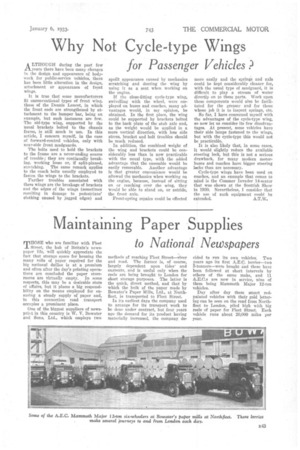Why Not Cycle-type Wings
Page 57

If you've noticed an error in this article please click here to report it so we can fix it.
for Passenger Vehicles ?
A LTHOUGH during the past few years there have been many changes in the design and appearance of bodywork for public-service vehicles, there has been little alteration in the design, attachment or appearance of front wings.
it is true that some manufacturers fit unconventional types of front wing. those of the Dennis Lancet, in which the front ends are strengthened by attachment to the bumper bar, being an example, but such instances are few. The old-type wing, supported by the usual brackets bolted to the chassis frame, is still much in use. In this article, I concern myself, in the case of forward-control vehicles, only with near-side front mudguards.
The bolts used to hold the brackets to the frame are a never-ending source of trouble; they are continually breaking, working loon or, if split-pinned, stretching. The same remark applies to the coach bolts usually employed to faeten the wings to the brackets.
Further troubles associated with these wings are the breakage of brackets and the edges of the wings (sometimes resulting in damage to pedestrians' clothing caused by jagged edges) and spoilt appearance caused by mechanics scratching and denting the wing by using it as a seat when working on the engine.
If the close-fitting cycle-type wing, swivelling with the wheel, were employed on buses and coaches, many advantages would, in my opinion, be obtained. In the first place, the wing could be supported by brackets bolted to the back plate of the stub axle and, as the weight would be applied in a more vertical direction, with Ices side stress, bracket and bolt troubles should be much reduced.
In addition, the combined weight of the wing and brackets could be considerably less than is now practicable with the usual type, with the added advantage that the ensemble would be easily removable. Another advantage is that greater convenience would be allowed the mechanics when working on the engine, because, instead of sitting on or reaching over the wing, they would be able to stand on, or astride, the front axle.
Front-spring repairs could be effected more easily and the springs and axle could be kept considerably cleaner for, with the usual type of mudguard, it is difficult to play a stream of water directly on to these parts. Work upon these components would also be facilitated for the greaser and for those whose job it is to inspect springs, etc.
So far, I have concerned myself with the advantages of the cycle-type wing, so now let us consider its few disadvantages. At present, some vehicles have their side lamps fastened to the wings, but with the cycle-type this would not be practicable.
It is also likely that, in some cases, it would slightly reduce the available steering lock, but this is not a serious drawback, for many modern motorbuses and coaches have 'bigger steering leeks than are necessary.
Cycle-type wings have been used on coaches, and an example that comes to inind is the Com=er Invader 14-seater that was shown at the Scottish Show in 1930. Nevertheless, I consider that the use of such equipment could be extended. A.T.W.




























































































